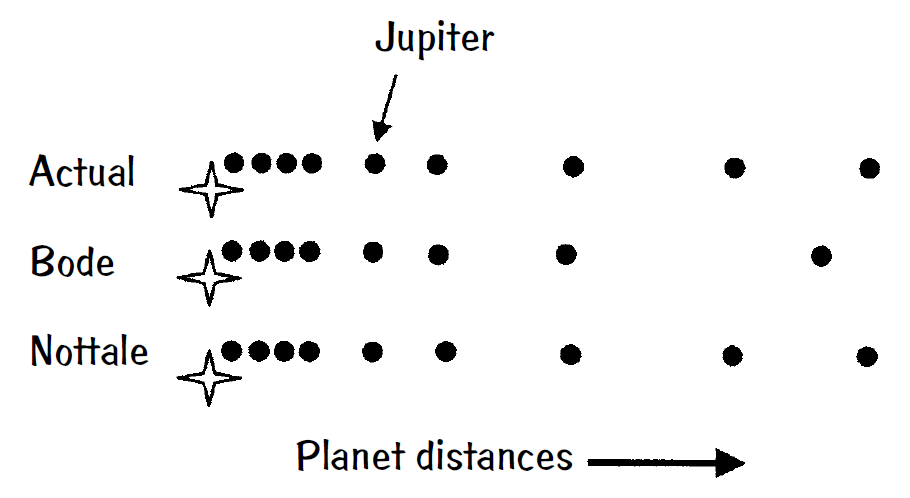


 الفيزياء الكلاسيكية
الفيزياء الكلاسيكية
 الكهربائية والمغناطيسية
الكهربائية والمغناطيسية
 علم البصريات
علم البصريات
 الفيزياء الحديثة
الفيزياء الحديثة
 النظرية النسبية
النظرية النسبية
 الفيزياء النووية
الفيزياء النووية
 فيزياء الحالة الصلبة
فيزياء الحالة الصلبة
 الليزر
الليزر
 علم الفلك
علم الفلك
 المجموعة الشمسية
المجموعة الشمسية
 الطاقة البديلة
الطاقة البديلة
 الفيزياء والعلوم الأخرى
الفيزياء والعلوم الأخرى
 مواضيع عامة في الفيزياء
مواضيع عامة في الفيزياء|
Read More
Date: 5-10-2016
Date: 6-11-2016
Date: 25-10-2016
|
Planetary Spacings
For some people the orbital radii for the planets in the Solar System seem to follow a regular pattern. The pattern was originally called the Titius-Bode law before Pluto was discovered. According to this numerical scheme, the semimajor axis of a planet’s orbit a = 0.4 + (0.3) 2n, where n is taken as negative infinity for Mercury, zero for Venus, and has increasing integer value by one unit for each successive planet. Neptune does not fit in this scheme, and the scheme may not represent an underlying physics.

In the 1990s, applying chaos theory to gravitationally bound systems, L. Nottale found that statistical fits indicate that the planet orbital distances, including that of Pluto, and the major satellites of the Jovian planets, follow a numerical scheme with their orbital radii proportional to the squares of integers n2 extremely well! The planets were divided into two groups, the inner planets Mercury, Venus, Earth, and Mars being at n = 3, 4, 5, and 6, respectively, and the outer planets, starting with Jupiter at n = 1. The two sets can be combined into one set with Mercury at n = 3, Jupiter at n = 10, and so on. The lack of planets at some integers can be attributed to the history of the Solar System and does not indicate a failure of the prediction.
Other researchers claim that the Nottale sets of integers are not unique and that several alternative sets of integers exhibit excellent fits, raising the question of whether there is actually a unique pattern in the orbital spacings. In addition, there are known orbital resonances for the satellites of the Jovian planets that cause some of the apparent patterns in the satellite spacings.
How would you determine whether any of the claimed patterns are physically significant or simply numerology?
Answer
The orbital radii of the planets only roughly follow the Titius-Bode law, so this specific pattern is probably bogus. However, L. Nottale and his research group have shown that the planets obey a generalized Schrodinger-like wave equation (with one unknown parameter) that has solutions dictating a regular pattern for where orbiting bodies reach an equilibrium radius. The planets of the Solar System occupy only these radial positions and leave some equilibrium radii unoccupied, perhaps a consequence of their history of formation. However, even though Nottale’s fits are extremely good, there are several other sets of small integers that statistically fit as well as the set proposed by Nottale, including many sets with larger integers.
Extra solar planetary systems with three planets have been found, but their statistical fits allow several sets of integers also, so they are not yet the definitive test. Unfortunately, we must wait for a definite extra solar system or a precise laboratory test to resolve the issue of whether the patterns are simply numerology or an exhibit of part of a new fundamental gravitational theory.



|
|
|
|
لخفض ضغط الدم.. دراسة تحدد "تمارين مهمة"
|
|
|
|
|
|
|
طال انتظارها.. ميزة جديدة من "واتساب" تعزز الخصوصية
|
|
|
|
|
|
|
مشاتل الكفيل تزيّن مجمّع أبي الفضل العبّاس (عليه السلام) بالورد استعدادًا لحفل التخرج المركزي
|
|
|